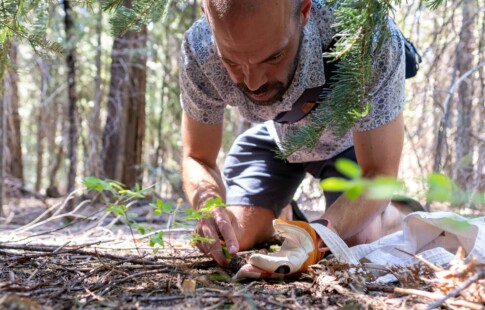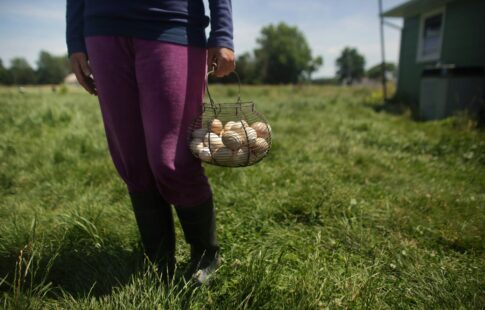
Mushroom Leather to Algae Plastic: 12 Wild Plant-Based Trends You Need to Know
We are reader-supported. When you buy through links on our site, we may earn affiliate commission.
Whether you’re eating an innovative meat replacement or wearing a faux leather jacket, plant-based trends vary across industries in their creativity and carbon impact. Relying less on animal products moving forward will help the climate heal, especially as raising animals for food, textiles, and other production consumes copious resources beyond what the planet can handle. Discover what is making waves in different sectors — all powered by plants.
1. Mushroom Leather
Mycelium is one of the plant-based trends that is changing everything because it is plentiful and dependable. The material is extremely durable, and mushroom roots have been shown to make a reasonable alternative to fashionable leather products. This minimizes animal agriculture and the demand for oil-based synthetics. The fashion industry is one of the most wasteful on Earth, so lowering the need to harvest intensive materials that cannot degrade in landfills is essential for changing the sector.
2. Lab-Grown Meat
Singapore sold some of the world’s first products with traces of lab-grown meat in the last couple of years. Though the trend has been met in the Western world with much skepticism and controversy, cellular agriculture could be the best way to satisfy the cravings of meat-eaters while cutting out the immense methane and carbon emissions associated with raising cattle, pigs, and other livestock.
3. Seaweed and Algae Packaging
Seaweed and algae are biodegradable yet sturdy packing materials. They lower the need for plastic and reliance on fossil fuels. Because it is renewable and naturally plentiful, companies have plenty of ways to source and grow it ethically. Seaweed farms are also great ways to sequester carbon.
4. Plant-Based Seafood Alternatives
Companies like Beyond and Impossible have changed the game when it comes to plant-based meat replacements. They strive to taste and look like the real thing. However, plant-based seafood alternatives have not become more common until recently. Plant-based trends are trying to find a replacement for the world’s most destructive activities.
Companies are making them out of creative ingredients like jackfruit and algae. Reducing overfishing is crucial for preserving marine ecosystems, especially when humans fish faster than most populations can reproduce.
5. Upcycled Food Ingredients
Upcycling is essential for giving new life to wasteful industries, like fashion and packaging. However, people can also repurpose old food ingredients to continue nourishing the planet and helping it overcome scarcity. Examples include used grain from breweries or fruit pulp, which can supplement tons of products, including candies and veggie proteins.
6. Precision Fermentation for Dairy Alternatives
Shoppers have become so entranced by milk alternatives that traditional milk companies are spending tons of money on advertising to try to regain customers. Microorganisms could create another variant that is protein-dense without animals. This reduces land use requirements for the dairy industry and cuts greenhouse gas emissions from cows.
7. Insect-Based Plant Fertilizers
The waste by-product from insects, known as frass, can be used as a fertilizer or an addition to plant-based compositions. More people are composting than ever before, but finding as many avenues to heal soils and nourish crops is essential when the land is so depleted of nutrients. It also prevents people from needing to rely on chemicals and synthetics.
8. Plant-Based Egg Replacers
Eggs are one of the trickiest animal products to replicate. However, chickpea brine, also called aquafaba, is a suitable and inexpensive way to get the components of an egg without the animal. You can use it to bake a vegan cake without affecting the taste.
9. Wild Food Foraging
Humanity’s ancestors have long been hunters and gatherers. Curious minds would forage for berries and medicinal herbs on a regular basis. It fell out of fashion, and because of social media trends, food independence, and faster dissemination of information, people are getting interested in edible wild plants again. It helps boost communities’ literacy about native wildlife. It has also created a culture focused more on self-sufficiency and separating itself from the toxic structure promoted by capitalist infrastructure.
10. Mushroom-Based Construction Materials
Mycelium from mushrooms turns out to be a strong building material. It can construct bricks or be designed as insulation to protect building envelopes. These replace resource- and energy-intensive processes that have been in conventional construction for decades. Concrete is a massive carbon emitter, and getting ethically harvested timber is challenging for many places. The more options there are for construction firms, the better the future’s buildings will be.
11. “Ugly” Produce Movement
A large portion of perfectly edible food goes to landfills because of its appearance. A bruise, bump, or scratch may keep it from being served at dinner. However, more stores are designating specific areas for “ugly” foods and selling them at a discount to raise the chances of them being sold. These initiatives are critical for preventing food waste and setting new precedents for how food should look.
There are even some online grocery stores that only sell those “imperfect” foods, sending them to environmentalists who want to avoid plastic packaging and wasteful practices of big-box grocers.
12. Regenerative Agriculture Practices
Regenerative agriculture has existed for as long as humans have been putting food in the ground. However, like many industry practices, it comes and goes depending on demand. Farmers have needed to use more intensive, exploitative practices to grow as much food as fast as possible. Continuing to do this will completely deplete the Earth of the nutrients that keep plants healthy.
The fear has caused regenerative agriculture to come back into fashion. It has countless benefits, including improved soil health, water retention, and carbon sequestration abilities. Restoring the land will also promote more pollinators and native wildlife to enter the area, protecting farms from invasive pests and other deterrents.
The Future’s Plant-Based Trends
Who knows what plants will be used for in the next decade or century, but based on these examples, the only thing we know is that they will be stretching humanity’s ingenuity. People are using plant-based materials to produce renewable energy and treat water more. Focusing on renewable, plant-based resources helps the planet heal from years of exploitation. What could industries conceive of next?
Share on
Like what you read? Join other Environment.co readers!
Get the latest updates on our planet by subscribing to the Environment.co newsletter!
About the author
Grace Waters
Always inspired by the natural world around her, Grace grew up exploring tide pools and hiking mountain trails, developing a deep appreciation for biodiversity and conservation. Now, Grace works as the Senior Editor of Environment.co where she covers topics related to emerging clean technologies, zero-waste initiatives, and the intersection of environmental policy and everyday living.





